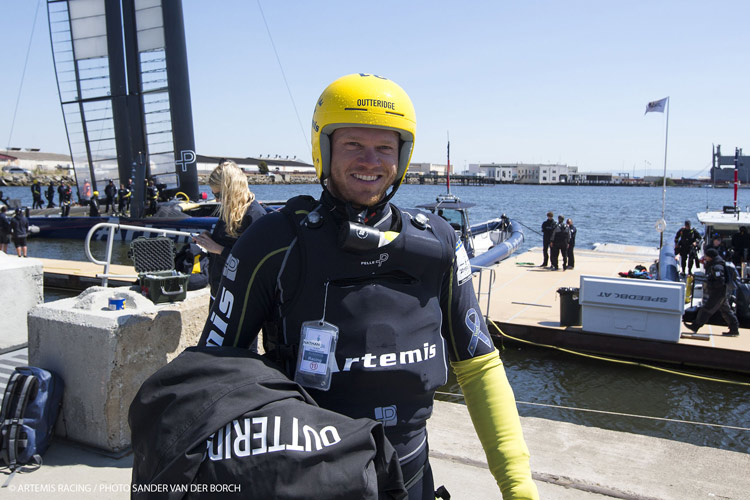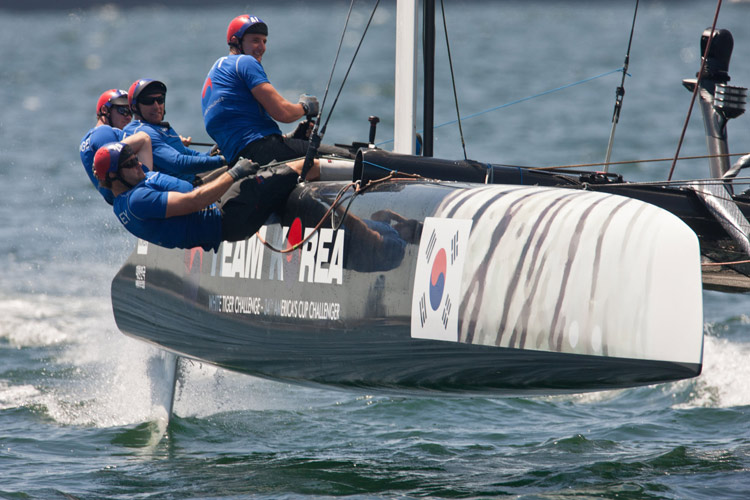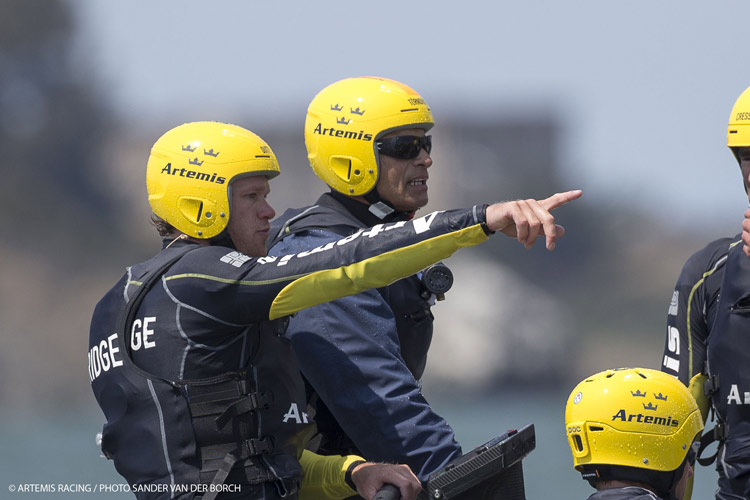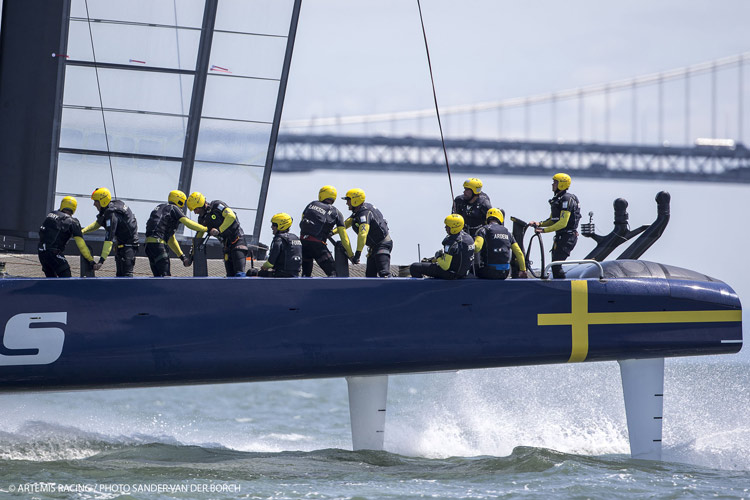Nathan Outteridge and The America's Cup
Expert Small Boat Sailors Vital to Making the AC72's Fast
San Francisco, September 6, 2013

Image:©2013 Sander van der Borch/Artemis Racing
In the 1970s and 80s America's Cup crews were largely composed of young sailors under 30 years old, often even as skippers. In the 20-25 years since, a professional rank emerged, and a number of sailors stuck around the event, becoming familiar faces and in the process raising the average age of the competitors. Many of the skills needed to make 2013 America's Cup boats go fast, however, came out of a different sailing tradition, and opened the door for a whole flock of young talented sailors who never expected their résumés would lead to an America's Cup career. Nathan Outteridge talks about transitioning from a small Olympic dinghy to a big AC45 to a huge AC72, becoming a leader at Artemis, and learning to race a foiling wingsail multihull in eight days:
The Australian Nathan Outteridge is among the most prominent of the new generation of America’s Cup sailors, the “Young Guns” who found unexpected opportunities when radical catamarans became the next generation Cup boat. As the required skill sets for sailing the AC45 and AC72 became apparent to the 2013 America’s Cup teams, suddenly younger athletic sailors with experience on high-performance boats were in demand. From winning a Gold Medal in the two-person, 94 kg-hull-weight 49er dinghy last summer, Outteridge ended up at the wheel of a 72-foot 40-plus-knot Louis Vuitton Cup challenger this year.
“I can say, guaranteed, that if the America’s Cup stayed in keelboat, if they’d stayed with the Version Five boats or something similar, I’d still be sailing my 49er back in Australia,” Outteridge confirmed. “The opportunity to get involved in the America’s Cup this time has been completely different – suddenly we were sailing [AC]45 cats that sail like dinghies.”
Outteridge started his Cup career with the smaller Team Korea, an America’s Cup World Series competitor that was ultimately unable to field an AC72 campaign. He was following in the footsteps of Chris Draper, who also broke in with Team Korea and then jumped to Luna Rossa Challenge.
 |
|
|
Outteridge, at far left, skippering Team Korea in Newport, summer 2012. Image:©2013 ACEA/Gilles Martin-Raget |
|
Other rising stars in the sport like Paul Campbell-James and Phil Robertson also found opportunities in the ACWS, and Peter Burling later took Outteridge’s place at Team Korea before winning the Red Bull Youth America’s Cup. 49er Gold Medalists and World Champions Iker Martinez and Xabi Fernandez, along with Iain’s own Olympic mate Iain Jensen, were yet more 49er talent flowing into the America’s Cup realm.
“Chris was really the first one who got the chance and he really excelled,” Outteridge says. “If it wasn’t for Chris, then they wouldn’t have come to the rest of us 49er and dinghy sailors, offering jobs.”
In September 2012, Outteridge was picked up by Artemis Racing and thrust onto an even bigger stage as it became clear that the giant catamarans would be fully foiling downwind. Nearly overnight, Outteridge was in a leadership role with people coming to him for answers. The young Aussie credits Iain Percy with quickly integrating him into the team.
“Percy did a great job of embracing the younger guys, guys who
had experience in foiling boats and letting us have some input,” says
Outteridge. “In previous Cups, you’d never have that chance, you’d just
sit there and listen and learn. That’s what I thought was going to happen
here. When I joined the team, I was the backup helmsman behind Terry
[Hutchinson] and Loïck [Peyron]. When we shifted to foiling everyone
looked at me and asked what I thought, and that was really cool, to have that
development and to be integral in so many aspects of the boat."

Image:©2013 Sander van der Borch/Artemis Racing
With a lot to learn about both wings and foils, the time spent on the AC45’s was the stepping stone from a small two-person dinghy to the AC72. Especially for Artemis, who didn’t bet on foiling initially.
“First off, not many people had sailed with wings before, so having a pretty basic wing, with not much control except for twist and camber, you could learn how to deal with that first,” Outteridge says. “The only thing that was really missing from the 45 was foiling, so we turned our AC45 into a foiling boat in March, were out sailing by April, and did about 35 days foiling on the 45. If we hadn’t done that, there’s no way we would have sailed in the America’s Cup.
“Everything that we learned from sailing a foiling 45 scaled up to a 72, in terms of how to trim, how to steer, how the dagger board works, how the rudder lift works -- all these complicated things that you see the 72s doing. From the outside, you just see a boat sailing around, but all the little details we learned from the 45 in the space of two months.
“We were designing boat two to foil while we were sailing the 45, so there would be critical moments when we would come in and say ‘We need to have this system on the 72 otherwise it’s not going to work.’ So that kept delaying boat two. Boat two was basically designed before I joined the team, but as we started to learn that boat one wasn’t performing the way we needed it to in order to be competitive, they started changing the design of boat two.
“When we first started sailing Moths, we had big foils with really aggressive control systems and as we got better, we made the foils smaller and smaller and we’d go faster and faster. But we didn’t have time, so we decided that our first set of foils would be what we thought were small foils. A second set would be a refined set of small foils. So basically we got a foiling 72 that was going to be really hard to sail because if we designed a big set of foils to learn on, we were going to be too slow. And we didn’t have any time.”
Heady stuff for a 27-year-old who, nine months after experiencing the high of winning an Olympic gold medal, found himself dealing with the worst of lows -- the accident that destroyed boat number one and took the life of teammate Andrew “Bart” Simpson. From sailing single-handed Moths and the double-handed 49er, Outteridge was helping to keep a team of 130 people moving forward. With little sailing available while the second Artemis boat was being altered, Outteridge headed to New Zealand on a spy mission.
“I went to New Zealand for two weeks to watch what they were doing and came back and said ‘We need this size rudder.’ What we got was 90 percent of what they had -- and we had eight days of training and they had 80. It was really impressive to see that our design team was able to shift from the direction they were going. It’s really hard to swallow your pride and say ‘We’re wrong, so let’s go in this direction and let’s listen to a young guy who’s never been in the Cup before and get his ideas.’”
It wasn’t possible to equal the prep time the other teams had,
but the effort to get the second Artemis boat on the water and ready for racing
was enormous.

Image:©2013 Sander van der Borch/Artemis Racing
“We were sailing every day we could, so what we learned on one day, we had to implement the next,” Outteridge says. “You have to stop on the water, stop for half an hour and talk to the guys on the chase boat about everything – does the rudder look okay, do we need change this or that – and give guys time to digest what happened. Half an hour later, you’re doing 40 knots again, just trying to learn as fast as you could. We had a really good plan of how to learn, but it was the steepest learning curve I’ve ever been on. Everyone on the team would say that – it’s just a shame it had to end so soon.”
With Artemis out of the Louis Vuitton Cup, ACTV put the young Outteridge to work as a broadcast analyst providing commentary alongside Tucker Thompson and Andy Green. All that time closely watching the other teams’ maneuvers in order to plan the Artemis choreography suddenly came in very handy.
“I spent this whole year watching Team New Zealand, Prada, and Oracle sail, watching video after video to see what they were doing. The one-boat races were better for us than the two-boat races, because we could see exactly what was going on. We could analyze specifics – at this time before a maneuver, the strategist crosses the boat and goes to the pit, then the trimmer runs across and so on. You can see them stand on the buttons to switch gears on the winches. That kind of analysis helped us so much, because we could watch details of what they were doing.
“So now that I see them racing, I have a really good understanding. I can see a certain guy cross the boat and know there’s a gybe coming in the next 30 seconds, which are tiny little details that no one picks up. So now, while I’m commentating, I’m trying to observe those little things as triggers to what’s about to happen and I’m trying to pick up little details when they do something good or when something abnormal happens. The main thing to watch is the starts and where they position themselves, what they do around mark one and at the bottom marks.”
Once this Cup cycle ends and his TV-analyst career is on hold, Outteridge may have the time and distance to put into perspective everything that happened during the past year. Until then, what advice would he have for the young 49er sailor that he was not that many months ago, setting out to take a chance on the America’s Cup?
“Just be prepared to deal with whatever happens. Know that things aren’t going to go as you planned and learn as much as you can, about things that aren’t even relevant to sailing.”
-- Diane Swintal for CupInfo/©2013 CupInfo.com

Image:©2013 Sander van der Borch/Artemis Racing
Additional Links and Info:
Daily Race Calendar for 2013 Louis Vuitton Cup and America's Cup